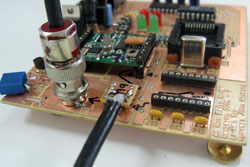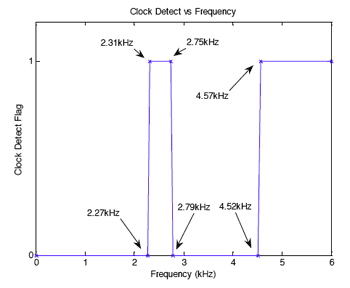|
| Wideband CMOS Switch under test |
Hardware
The hardware platform worked as expected, with the newly added real time clock working brilliantly as a time-keeper for the sleep schedule. The Wideband CMOS switch consumes so little current that it cannot be measured with a multimeter. The measured port separation of the switch was approximately 35 dB (Data sheet specifies 43dB) - this is easily sufficient to prevent oscillations in the amplifier, however it shows that there is still room for improvement in the RF design of the PCB. In particular, the use of IC sockets to attach RF IC carrier boards appears to have caused some insertion loss.
Back To Top
|
| Clock Detect Flag vs Frequency |
Manchester Encoding/Decoding
There were several problems with undocumented bugs in both the MPSIM simulation enviroment, and the ICE2000 emulator. However, the workarounds for these bugs actually reduced the number of processor cycles required for encoding. The use of "processing slack" was proven by pushing the encoder to its theoretical speed limit of 11.628 kbps. The clock detect mechanism was also proven to work very well, with a clock rate tolerance of 8.5%.
Back To Top
Power Saving Techniques
The scheduled rendezvous mechanism was implemented and verified, as well as a basic synchronisation mechanism. It was found that because the timer used for the sleep schedule only has a resolution of 1 second, an error of up to 1 second occurs with each synchronisation hop. This is easily compensated for by adding one second to the clock each time a synchronisation occurs.
The preamble sampling technique was modelled, and the assumptions made about the hardware were experimentally verified. A basic adaptive preamble sampling protocol was implemented and verified, however software simulation is required to verify and better understand other aspects of the technique.
Back To Top
Dynamic Address Allocation
The dynamic address allocation protocol was partially implemented in the ns-2 network simulator, however there were severe problems getting the code to compile and run. This was mainly due to the complexity and poor support for the simulation software, despite its ubiquity amongst the research community. Due to time restrictions, development was terminated before any results could be obtained.
Back To Top
Future Work
Software Simulation
The power saving protocol has been implemented and tested
on the microcontroller hardware, and sufficient results have been obtained to conclude
that the protocol is capable of providing significant power savings. However, there are
no results which quantify the power savings for realistic network scenarios. Similarly,
the new dynamic addressing protocol definitely provides power savings over its
predecessors; however the exact improvement has not been quantified. A focus of future work will be software simulation of these, and other protocols to better understand and improve upon them.
Back To Top
Location Discovery
Because the nodes do not have MAC addresses and network addresses are
dynamically assigned, the nodes have no hard coded identification number.
Consequently, once the nodes have been deployed, the only way to tell which node is
which is with application layer support.
Other ad hoc networks face a similar problem where the nodes are not deployed to
known locations, for example if an area is blanketed with nodes for surveillance. An
obvious solution is to attach a GPS module to each node, however this is costly,
bulky, and power consuming. An alternative is to use a distributed location discovery
algorithm, which uses triangulation to calculate the relative positions of each
node, given there are three nodes whose absolute positions are known.
The triangulation algorithm typically uses the received signal strength indicator
(RSSI) as a measure of the distance between nodes. Unfortunately, in a sparse outdoor
ad hoc network, problems such as localised geography, multi-path propagation, and
weather conditions will likely make this measurement unsuitable. However, the long
distances between nodes make it viable to use propagation delay as a measure of
distance. Assuming that a 20 MHz PIC microcontroller can measure propagation
delay to a precision of 200 nanoseconds 2, distance can be calculated to a precision of
60m.
This is clearly only possible in ad hoc networks with large distances between nodes,
thus it is a unique possibility for this project, and should be investigated further in a
subsequent thesis.
Back To To


